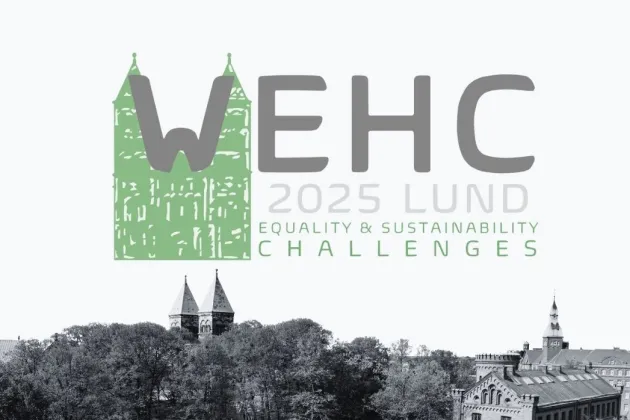“I was very nervous right up until Monday morning, when it all started,” recalls Professor Mats Olsson, one of the lead organizers from the Department of Economic History at Lund University School of Economics and Management (LUSEM). “But when I saw that everyone was there – the volunteers, the participants – and Igor seemed calm… then I relaxed. Everything was coming together just as we’d hoped.”
The “Igor” Mats refers to is Igor Martins, a colleague and researcher at the Department of Economic History, who also served as co-organizer and host of the congress.
Economic history strong in Lund
The congress highlighted Lund’s unique position in economic history: LUSEM’s Department of Economic History stands as the largest in the world, followed by the London School of Economics and Utrecht University. The congress not only showcased the department’s global reach but also confirmed Lund’s capacity to host major international research events. At the same time, it was record-breaking in scale. With 1,200 participants from about 60 countries and 18–20 parallel sessions four times a day during four days, it was the largest academic congress ever held in Lund — surpassing the previous record of 900 attendees at a biology congress ten years earlier. For Igor, it was a striking realization: “I only just learned that this was the biggest academic congress ever hosted in Lund. I’m still processing that.”
From LUSEM alone, 61 scholars presented their work — five percent of the entire programme. Sweden also has a special history with the congress: after hosting the very first in 1960, it is now one of only three countries (together with France and the US) to have hosted it twice.
New collaborations and future research
The congress also sparked new research ideas and collaborations. Mats, who was involved in three different sessions, described them as “very interesting perspectives for developing new research,” particularly the one on women’s labor, which connected directly to the first keynote lecture. Inspired by these discussions, he and colleagues are now planning a workshop in Lund next autumn on men’s and women’s work from medieval times to the 20th century, examining long-term changes and building on the well-known Claudia Goldin curve.
For Igor, the congress was equally valuable in strengthening ongoing projects.
“I met some people I have been working with but had never met in person,” he explains. “Finally sitting down together re-energized the project and gave it new momentum.” His current collaboration focuses on inequality in pre-colonial Angola.
Shaping the future of economic history
Looking ahead, the World Economic History Congress will continue to play a central role in the discipline. Held every three years, it is the most important recurring event for economic historians worldwide — a forum where researchers gain a broad and international perspective on their field. Not every presentation represents finished work; many are early-stage ideas or projects in development. This openness creates opportunities for feedback, inspiration, and new collaborations. As Mats puts it, the congress is not only an academic gathering but also a kind of “workplace party,” where colleagues reconnect after years apart, put faces to the names they know from publications, and welcome new generations of scholars into the community.
For early career researchers, the event can be especially transformative.
“It’s a great opportunity to network,” says Igor. “You meet people outside your own niche, and those encounters can open doors to new collaborations and funding opportunities. For me personally, being part of the organizing team also meant increased visibility — people now know my name and what I work on, which will be valuable in the long run.”
The student perspective
Beyond the lectures and research sessions, the congress also made a lasting impression on the students who helped make it happen. With 1,200 participants — of which only about 50 joined remotely — the event demonstrated the continuing value of coming together in person to exchange knowledge, build networks, and celebrate the discipline. Student volunteers coordinator Elsa Fridell noted the atmosphere of engagement on-site throughout the week: “Everyone seemed so happy. They were sitting outside having picnics, discussing what they had just heard.”
She continues: “Like many of the volunteers I spoke with, I found the congress to be such a unique opportunity to as a student learn more about your topics of interest, gather ideas for a potential thesis, and to be able to meet the people whose work you have read in class. The whole event was truly inspiring and has given me so much motivation to begin the third year of my bachelor’s.”
“This congress has also been a great opportunity to explore academia at a low stakes stage and to learn more about different career prospects,” Elsa concludes.
Opening the doors to the public
In connection with the congress, the Department of Economic History also collaborated with Lunds kommun (Lund municipality) to arrange a series of open lectures for the general public. Mats admits he was initially uncertain about the idea.
“In the middle of the summer, what are the odds that people would actually show up?” he recalls. “The very first lecture featured two Danish professors speaking about Denmark in the Middle Ages — I thought nobody would come. But the room was full, and for the later lectures it was even fuller. At the last two, people were actually standing.”
The success of the open sessions highlighted the public’s appetite for historical perspectives and showed that large-scale academic events can also resonate far beyond the university.
“It demonstrates that Lund can host a major scientific congress in the city center — and that we have paved the way for more to come,” Mats concludes.



